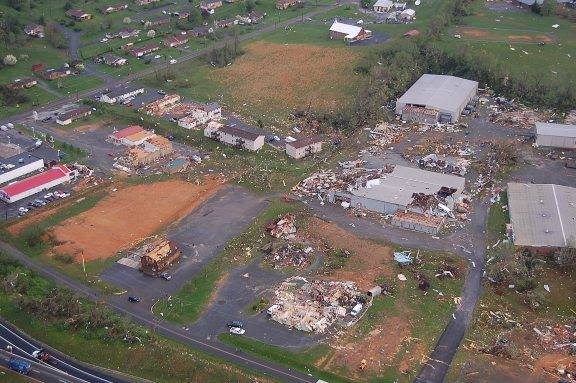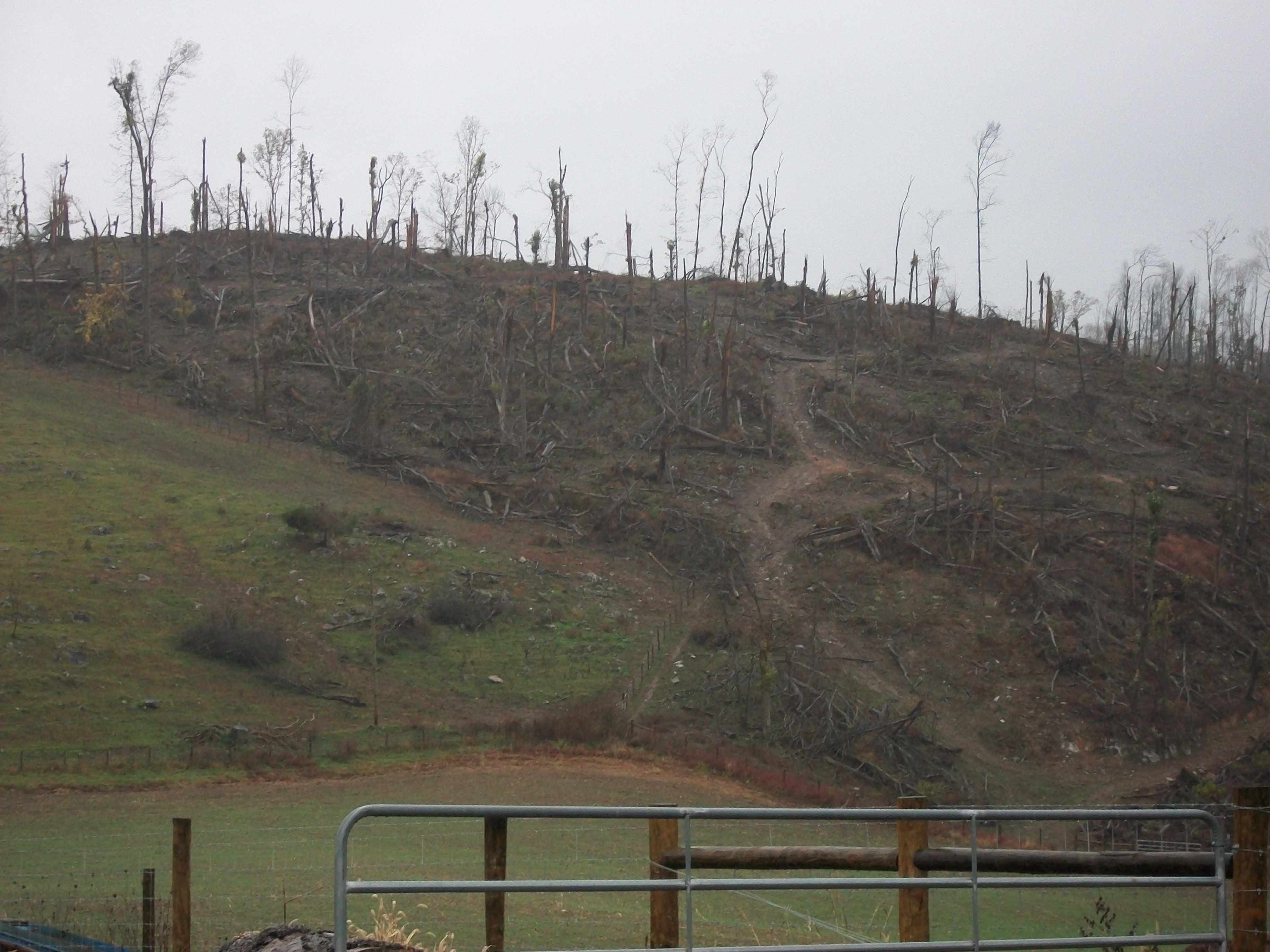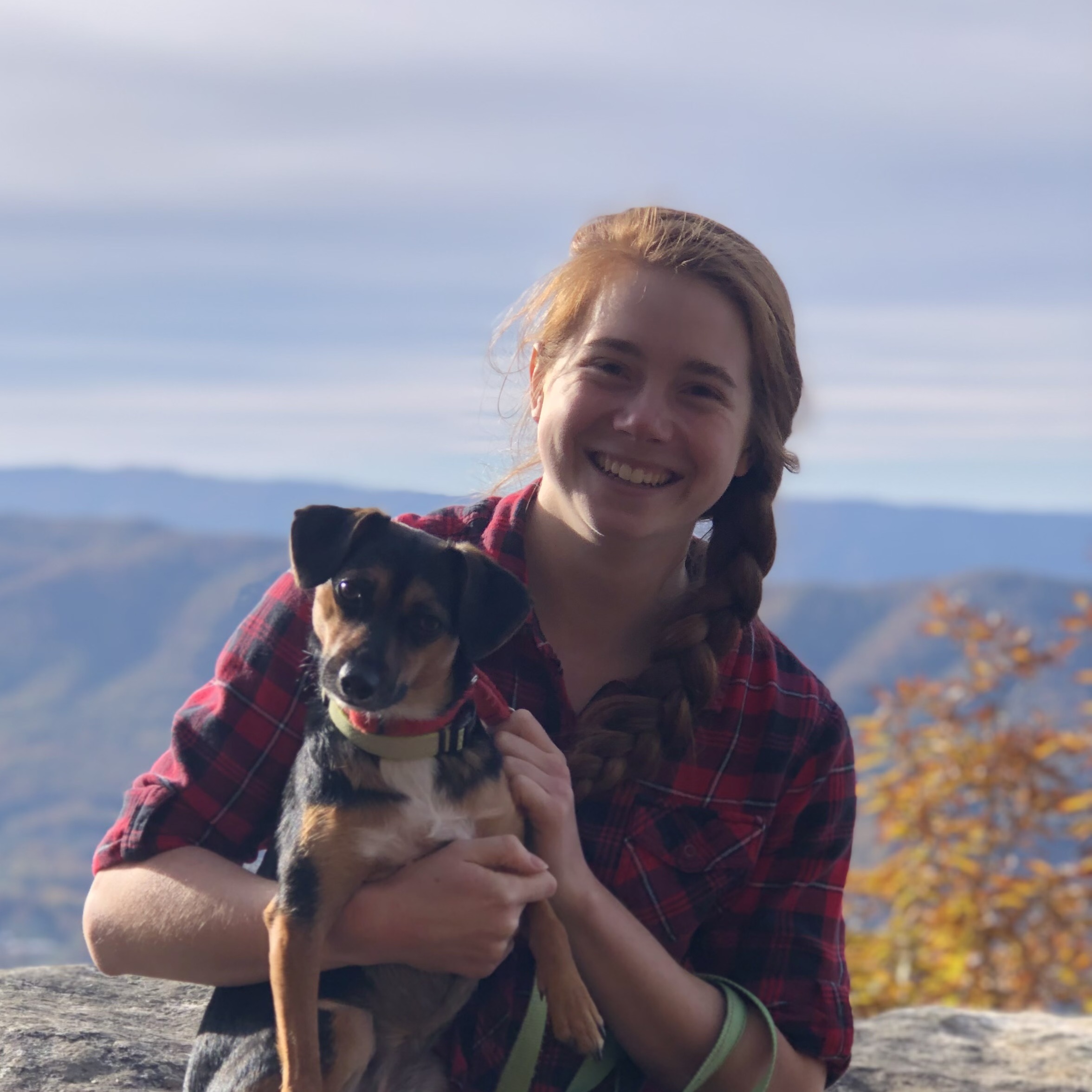Case Study of Urban Reforestation Efforts a Decade After Tornado Destruction of a Southwest Virginia Community
This study is conducted by the Virginia Tech College of Natural Resources and Environment with grant funding from the Virginia Department of Forestry.
Overview
In April 2011, the southeastern United States was hit by the largest outbreak of tornado events in recorded history. The hundreds of tornadoes left the region in a state of destruction with hundreds of lives lost and billions of dollars in damages. On April 28th, 2011, an EF3 tornado with wind speeds nearing 140 mph passed through the southwest Virginia community of Glade Spring, carving a path of destruction 20 miles long and almost a mile wide.

Glade Spring typifies many small communities interspersed between large metropolitan areas across Virginia and much of the Southeast that was heavily impacted by the effects of the tornado destruction. In this rural residential setting, hundreds of shade trees populating yards, parks, and streetscapes were damaged or destroyed. Most large trees along the tornado’s path were completely delimbed by the extreme winds, leaving behind dead-standing trees with no viable option other than to cut them down completely. We are seeking to examine the factors associated with successful tree canopy replenishment, growth, and the provision of urban forest ecosystem services in Glade Spring, VA a decade after the tornado.
Natural Disaster
Over 400 homes and businesses were heavily damaged or completely destroyed, resulting in over $78 million in losses. Three fatalities and 52 injuries were documented. Damage and destruction of trees were widespread in the community. As a result, the community forest was severely devastated, leaving barren landscapes lacking shade and green amenities.
Recovery
The United Way of Southwest Virginia was essential in rebuilding and recovering Glade Spring during the recovery process. The community had been rejected from federal funding for recuperation and was left feeling abandoned and hopeless. However, the community responded with resilience to the tornado destruction.
Reforestation
The loss of trees due to the tornado motivated the United Way of Russell and Washington Counties to distribute tree saplings to 400 of the most heavily impacted households on the one-year anniversary of the storm. However, roughly 10-15% of the trees were given away. Local individuals had a choice of native non-tall species that would be powerline compatible






“It really broke our heart to lose all those trees,” a community member said. “And we hear more traffic noise from [Interstate] 81 now because we haven’t had trees.”
Bristol Herald Courier, 2013
Objectives
Spring of 2022 marked the ten-year anniversary of the United Way tree giveaway event and with that anniversary came an opportunity to reflect on the destruction caused by the tornado and examine the outcomes of the community’s reforestation efforts. This was an opportunity to learn how tree canopy cover has recovered from the tornado, what role tree planting played in that recovery, and how community members feel about the reforestation efforts. Our research accomplished the following objectives:
- Conduct interviews with local leaders and participants in the community reforestation project to document how the reforestation project was conducted.
- Perform geospatial analyses of the tree canopy along the tornado corridor to determine how the community forest was impacted and has since recovered.
- Conduct a household survey of parcels offered reforestation seedlings in 2012 to understand perceptions of the tornado’s impacts on the community forest and participation in the reforestation project.
- Conduct a site survey of parcels that offered reforestation seedlings in 2012 to locate those trees and assess their survival, growth, and landscape conditions.
- Cross-examine the geospatial analysis, household survey, and parcel survey to understand interrelationships between personal actions, tree survival, tree canopy recovery, and ecosystem services.
At the conclusion of our research, we will create a case study report summarizing the findings of our analysis and providing recommendations on how to improve the outcomes of reforestation projects in small communities.
Research Findings
Our research team has worked since January 2022 to better understand the Glade Spring reforestation. To do so, a study population of 353 parcels was randomly selected in Glade Spring, Virginia to study the effects of the 2011 tornado. The selection criteria for the sampling frame were single-family home parcels that were in the path of the 2011 tornado during its EF3 stage and ≤ 1.5 acres. These parcels were then analyzed using remote sensing and community surveying.
Remote Sensing
A remote sensing analysis was performed to determine the number of trees per parcel right before, right after, and several years after the tornado. NAIP 3-band color imagery with 1-meter spatial resolution was used to digitize trees in each of the parcels using ArcGIS Pro.
Community Survey
A survey was distributed to 353 parcels that focused on four components of the community’s response: Replanting Behavior, Tornado Perception, Arboriculture Knowledge, and Household Demographics. This had a response rate of 21.7% (75/346)
Field Inventory
The survey also asked for permission to conduct a field survey to locate trees, identify species, growth, survival, and locate their distance and direction from the household. In the field inventory, we assessed 142 trees planted after the tornado.
What Was Lost
From the survey data, it was found that overall 83% of respondents experienced tree damage. Adding to the residential and commercial damage brought on by the tornado, roughly 257 trees were lost within the study sample. The gross tree count for the entire study population declined by 20% after the tornado.
On average per damaged parcel, 4 trees experienced minor crown damage (<50% branch damage), 4 trees experienced major crown damage (>50% branch damage), 6 trees were destroyed, and 5 damaged trees were cut down.
What Was Recovered
The community forest recovered to 87% of pre-tornado levels by 2018. On average 6 trees were planted per parcel after the tornado. The most common type of trees planted were Eastern Redbuds (9%) and Kousa Dogwood (9%).
Through remote sensing we were able to gather that the average parcel lost 1.5 trees right after the tornado and recovered 0.5 trees from 2011 to 2018, however, there was a – 1.0 tree deficit per parcel in 2018. The average parcel likely lost one or two trees and replanted at least one tree after the tornado.


A distinct increase can be seen from the data that shows a 33% recovery rate over 10 years. This shows that reforestation efforts are progressing to restore the forests to their former state within the next 20 years. While the community forest has recovered some trees since 2011, the saplings that replaced mature, damaged trees are not equal replacements due to differences in physical size and canopy spread.
What Was Experienced
After the tornado the community was left traumatized and fearful of future storm damage. 88% of people who were extremely traumatized by the tornado now take numerous precautions compared to before. 62% of respondents reported that their planting choices were directly impacted by the tornado event. Individuals have planted small, ornamental trees at greater distances from their homes to combat the risk of potential tree damage. However, this may limit tree canopy recovery and the benefits of shade, such as home energy conservation. Landscape changes from the tornado damage have increased the need for windbreaks and hedge trees.
Fear of tree damage can persist after disaster events and lead individuals to distance or remove trees near the property. This comes at the cost of fewer tree benefits. Recognizing community anxieties during recovery after a natural disaster may increase the effectiveness of reforestation projects.
As a product of our research, we are constructing a StoryMap to contribute a visual element to our study, as well as a case study report to distribute to local governments and civil associations outlining strategies for a successful implementation of reforestation projects.
Get Involved
Glade Spring offers an excellent opportunity for a case study examining the ecological and social dimensions of small community forest restoration in the wake of a natural disaster. Small communities are rarely the subject of study for urban reforestation projects, so limited information exists on how to properly engage communities to ensure that projects are successful. By retrospectively studying Glade Spring a decade after its reforestation project, vital information can be gathered that will prove useful for reforestation projects in other small communities around Virginia.
Benefits of Urban Forestry
After a natural disaster, urban areas can be heavily depleted of the ecosystem services that come from an urban forest. The effects of this can be felt for years until the local forest recovers. Below are some benefits of urban tree coverage:
- Better Air Quality
- Temperature Control
- Stormwater Management
- Aesthetic Value

Resources for Preparedness and Reforestation
Click on the links below for more information on how communities can be ready to react to a natural disaster.
Virginia Department of Forestry: Storm Planning and Recovery
North Carolina Forest Service: Trees and Storms: Readiness, Response, and Recovery
Research Partners

Dr. Eric Wiseman, PhD
Project Leader
Associate Professor, Dept. of Forest Resources and Environmental Conservation
Virginia Tech

Dr. Mikaela Schmitt-Harsh, PhD
Collaborator
Associate Professor, Dept. of Interdisciplinary Liberal Studies
James Madison University

Will Brandt
Meteorological/ GIS Specialist, Undergraduate Research Assistant
Major: Geography and Meteorology
Ashburn, VA

Meghan Failor
GIS Specialist, Undergraduate Research Assistant
Major: Environmental Informatics
Fredericksburg, VA

Jennifer Ochs
Remote Sensing and Urban Forestry, Undergraduate Research Assistant
Major: Environmental Informatics
Springfield, VA

Seferina Olivo
Community Outreach, Undergraduate Research Assistant
Major: Environmental Resource Management
Abingdon, VA
